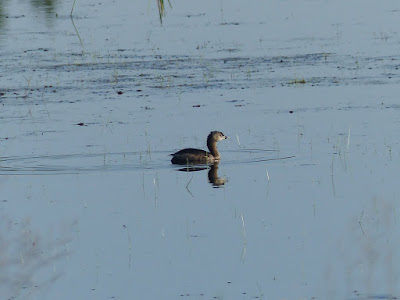 |
| American Golden-Plover, Whitesbog (digiscope) |
 |
| Pied-billed Grebe, Whitesbog |
Of course, the Wood Stork at Sandy Hook was the highlight of the month. The day I saw it had a semi-holiday vibe to it due to the partial eclipse.
Two species of phalaropes at Brig, along with two species of godwits there were also notable. Yes, I did go to Brig a few times on the weekends--Whitesbog after about 8 o'clock A.M. on a summer Saturday or Sunday gets a little too busy with the retriever people, the dirt bike people, and the let's drive around the dikes aimlessly people for birding to be productive or pleasant.
For the month I added 7 year birds (2 more than in July) and managed 143 species (30 species of shorebirds!), all but two in NJ. I listed pigeon and House Sparrow on the mean streets of Manhattan.
 |
| Green Heron, Whitesbog |
New Jersey: Atlantic, Burlington, Cape May, Monmouth, Ocean
New York: New York
Species
First Sighting
|
Snow Goose Brig
|
Canada Goose
Whitesbog
|
Mute Swan
Cape May
|
Wood Duck
Whitesbog
|
Blue-winged Teal Brig
|
Northern Shoveler Brig
|
Mallard
Whitesbog
|
American Black Duck Cape May
|
Northern Pintail Brig
|
Green-winged Teal Whitesbog
|
Black Scoter
Island Beach
|
Hooded Merganser Brig
|
Northern Bobwhite Cape May
|
Wild Turkey
Crestwood Village
|
Pied-billed Grebe Whitesbog
|
Wood Stork Sandy
Hook
|
Double-crested Cormorant Island Beach
|
Brown Pelican
Island Beach
|
Great Blue Heron Whitesbog
|
Great Egret
Whitesbog
|
Snowy Egret
Island Beach
|
Little Blue Heron Brig
|
Tricolored Heron Scotch Bonnet
|
Green Heron
Whitesbog
|
Black-crowned Night-Heron Brig
|
Yellow-crowned Night-Heron Scotch Bonnet
|
White Ibis Brig
|
Glossy Ibis
Island Beach
|
Turkey Vulture Brig
|
Osprey
Island Beach
|
Cooper's Hawk
Whitesbog
|
Bald Eagle
Whitesbog
|
Red-tailed Hawk Whitesbog
|
Clapper Rail
Brig
|
American Oystercatcher Island Beach
|
Black-bellied Plover Island Beach
|
American Golden-Plover Whitesbog
|
Semipalmated Plover Island Beach
|
Piping Plover
Island Beach
|
Killdeer
Cape May
|
Upland Sandpiper
Mercer Sod Farm IBA
|
Whimbrel
Brig
|
Hudsonian Godwit Brig
|
Marbled Godwit Brig
|
Ruddy Turnstone Cape May
|
Stilt Sandpiper Brig
|
Sanderling
Island Beach
|
Dunlin
Brig
|
Least Sandpiper Whitesbog
|
White-rumped Sandpiper Brig
|
Buff-breasted Sandpiper Whitesbog
|
Pectoral Sandpiper Whitesbog
|
Semipalmated Sandpiper Island Beach
|
Western Sandpiper Brig
|
Short-billed Dowitcher Island Beach
|
Long-billed Dowitcher Brig
|
Wilson's Snipe Whitesbog
|
Wilson's Phalarope Brig
|
Red-necked Phalarope Brig
|
Spotted Sandpiper Whitesbog
|
Solitary Sandpiper Whitesbog
|
Greater Yellowlegs Whitesbog
|
Willet
Brig
|
Lesser Yellowlegs Whitesbog
|
Laughing Gull
Island Beach
|
Ring-billed Gull Island Beach
|
Herring Gull
Island Beach
|
Great Black-backed Gull Island Beach
|
Least Tern
Cape May
|
Gull-billed Tern Brig
|
Caspian Tern
Brig
|
Black Tern
Brig
|
Common Tern
Island Beach
|
Forster's Tern Island Beach
|
Royal Tern
Island Beach
|
Black Skimmer
Brig
|
Rock Pigeon
901 Lexington Ave, New York
|
Mourning Dove
Whitesbog
|
Common Nighthawk 35 Sunset Rd
|
Eastern Whip-poor-will Whiting WMA
|
Chimney Swift
Whitesbog
|
Ruby-throated Hummingbird 35 Sunset Rd
|
Belted Kingfisher Cranberry Bogs--Dover Rd
|
Red-bellied Woodpecker Whitesbog
|
Downy Woodpecker Crestwood Village
|
Hairy Woodpecker Brig
|
Northern Flicker Cape May
|
Peregrine Falcon Brig
|
Eastern Wood-Pewee Whitesbog
|
Least Flycatcher Whitesbog
|
Eastern Phoebe Whitesbog
|
Great Crested Flycatcher Whitesbog
|
Eastern Kingbird Whitesbog
|
White-eyed Vireo Whitesbog
|
Red-eyed Vireo Brig
|
Blue Jay
35 Sunset Rd
|
American Crow
Cape May
|
Fish Crow
35 Sunset Rd
|
Northern Rough-winged Swallow Whitesbog
|
Purple Martin
Cape May
|
Tree Swallow
Whitesbog
|
Barn Swallow
Whitesbog
|
Carolina Chickadee Whitesbog
|
Tufted Titmouse Whitesbog
|
White-breasted Nuthatch 35 Sunset Rd
|
House Wren
Cape May
|
Marsh Wren
Brig
|
Carolina Wren
Cape May
|
Blue-gray Gnatcatcher Whitesbog
|
Eastern Bluebird Cranberry Bogs--Dover Rd
|
American Robin Cape May
|
Gray Catbird
Whitesbog
|
Brown Thrasher Whitesbog
|
Northern Mockingbird Cape May
|
European Starling 35 Sunset Rd
|
Cedar Waxwing
Whitesbog
|
Ovenbird
Cranberry Bogs--Dover Rd
|
Black-and-white Warbler Whitesbog
|
Common Yellowthroat Whitesbog
|
American Redstart Brig
|
Yellow Warbler Cape May
|
Pine Warbler
Whitesbog
|
Prairie Warbler Whitesbog
|
Canada Warbler Whitesbog
|
Saltmarsh Sparrow Brig
|
Seaside Sparrow Brig
|
Chipping Sparrow Whitesbog
|
Field Sparrow
Cape May
|
Song Sparrow
Whitesbog
|
Swamp Sparrow
Whitesbog
|
Eastern Towhee Whitesbog
|
Northern Cardinal 35 Sunset Rd
|
Blue Grosbeak
Brig
|
Indigo Bunting Cape May
|
Bobolink Brig
|
Orchard Oriole Whitesbog
|
Red-winged Blackbird Whitesbog
|
Brown-headed Cowbird Whitesbog
|
Common Grackle Whitesbog
|
Boat-tailed Grackle Island Beach
|
House Finch
35 Sunset Rd
|
American Goldfinch Whitesbog
|
House Sparrow
485 Lexington Ave, New York
|






